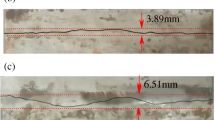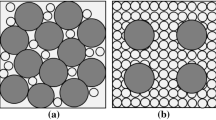Abstract
Tests of interface between compacted clay and concrete were conducted systematically using interface simple shear test apparatus. The samples, having same dry density with different water content ratio, were prepared. Two types of concrete with different surface roughness, i. e., relatively smooth and relatively rough surface roughness, were also prepared. The main objectives of this paper are to show the effect of water content, normal stress and rough surface on the shear stress-shear displacement relationship of clay-concrete interface. The following were concluded in this study: 1) the interface shear sliding dominates the interface shear displacement behavior for both cases of relatively rough and smooth concrete surface except when the clay water content is greater than 16% for the case of rough concrete surface where the shear failure occurs in the body of the clay sample; 2) the results of interface shear strength obtained by direct shear test were different from that of simple shear test for the case of rough concrete surface; 3) two types of interface failure mechanism may change each other with different water content ratio; 4) the interface shear strength increases with increasing water content ratio especially for the case of clay-rough concrete surface interface.
Similar content being viewed by others
References
Miller G A, Hamid T B. Interface direct shear testing of unsaturated soil. Geotechnical Testing Journal, 2006, 30(3): 182–191
Fleming I R, Sharma J S, Jogi MB. Shear strength of geomembrane-soil interface under unsaturated conditions. Geotextile and Geomembranes, 2006, 24: 274–284
Potyondy J G. Skin friction between various soils and construction materials. Geotechnique, 1961, 11(4): 831–853
Clough G W, Duncan J M. Finite element analyses of retaining wall behavior. Journal of the Soil Mechanics and Foundations Division, ASCE, 1971, 97(12): 1657–1673
Yin Z Z, Zhu H, Xu G H. A study of deformation in the interface between soil and concrete. Computers and Geotechnics, 1995, 17(1): 75–92
Acar Y B, Durgunoglu H T, Tumay M T. Interface properties of sand. Journal of Geotechnical Engineering, ASCE, 1982, 108(4): 648–654
Desai C, Drumm C, Zaman M. Cyclic testing and modeling of interfaces. Journal of Geotechnical Engineering, ASCE, 1985, 111(6): 793–815
Hu L M, Pu J L. Testing and Modeling of soil-structure interface. Journal of Geotechnical and Geoenvironmental Engineering, 2004, 130(8): 851–360
Zhou G Q, Xia H C, Zhao G S, Zhou J. Nonlinear elastic constitutive model of soil structure interfaces under relatively high normal stress. Journal of China University of Mining and Technology, 2007, 17(3): 301–305
Paikowsky S G, Player C M, Connors P J. A dual interface apparatus for testing unrestricted friction of soil along solid surfaces. Geotechnical Testing Journal, 1995, 18(2): 168–193
Evgin E, Fakharian K. Effect of stress paths on the behavior of sandsteel interfaces. Canadian Geotechnical Journal, 1996, 33(6): 853–865
Yoshimi Y, Kishida T. A ring torsion apparatus for evaluating friction between soil and metal surfaces. Geotechnical Testing Journal, 1981, 4(4): 145–152
Huck P J, Saxena S K. Response of soil-concrete interface at high pressure. In: Proceedings of the Tenth International Conference on Soil Mechanics and Foundation Engineering, Stockholm, 15–19 June, 1981. The Netherlands: A. A. Balkema, Rotterdam, 1981, 2: 141–144
Corfdir A, Lerat P, Vardoulakis L. A cylinder shear apparatus. Geotechnical Testing Journal, 2004, 27(5): 447–455
Coyle H M, Sulaiman I. Skin friction for steel piles in sand. Journal of the Soil Mechanics and Foundations Division, ASCE, 1967, 93(6): 261–270
Brummund N F, Leonards G A. Experimental study of static and dynamic friction between sand and typical construction materials. Journal of Testing and Evaluation, ASTM, 1973, 1(2): 162–165
Reddy E S, Chapman D N, O’Reilly M. Design and performance of soil — pile-slip test apparatus for tension piles. Geotechnical Testing Journal, 1998, 21(2): 132–139
Kisheda H, Uesugi M. Tests of interface between sand and steel in the simple shear apparatus. Geotechnique, 1987, 37(1): 45–52
Uesugi M, Kishida H. Influential factors of friction between steel and dry sands. Soils and Foundations, 1986, 26(2): 33–46
Uesugi M, Kishida H. Frictional resistance at yield between dry sand and mild steel. Soils and Foundations, 1986, 26(2): 139–149
Tsubakihara Y, Kisheda H, Nishiyama T. Friction between cohesive soils and steel. Soils and Foundations, 1993, 33(2): 145–156
Tsubakihara Y, Kisheda H. Frictional behavior between normally consolidated clay and steel by two direct shear type apparatus. Soils and Foundations, 1993, 33(2):1–13
Wang W, Lu T H. Modeling experiment on interface shearing behavior between concrete and unsaturated soil with various degrees of saturation. In: Yin Z Z, Yuan J P, Chiu A C F. Proceedings of the 3rd Asian Conference on Unsaturated Soils, Nanjing, China. Beijing: Science Press, 2007, 315–318
Uesugi M, Kisheda H, Tsubakihara Y. Behavior of sand particles in sand steel friction. Soils and Foundations, 1988, 28(1): 107–118
Uesugi M, Kishida H, Uchikawa Y. Friction between dry sand and concrete under monotonic and repeated loading. Soils and Foundations, 1990, 30(1): 115–128
Author information
Authors and Affiliations
Corresponding author
Rights and permissions
About this article
Cite this article
Shakir, R.R., Zhu, J. Behavior of compacted clay-concrete interface. Front. Archit. Civ. Eng. China 3, 85–92 (2009). https://doi.org/10.1007/s11709-009-0013-6
Received:
Accepted:
Published:
Issue Date:
DOI: https://doi.org/10.1007/s11709-009-0013-6




